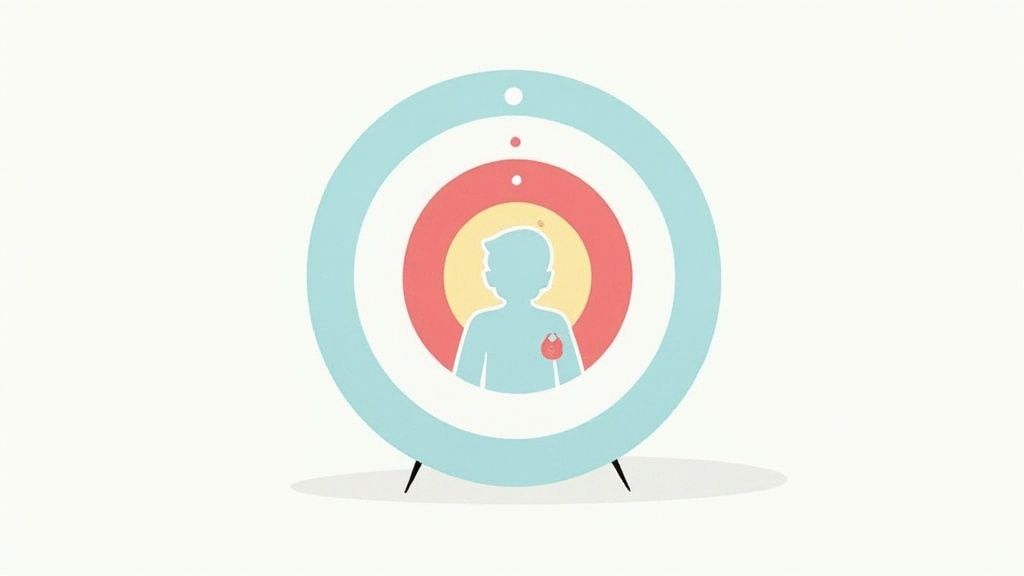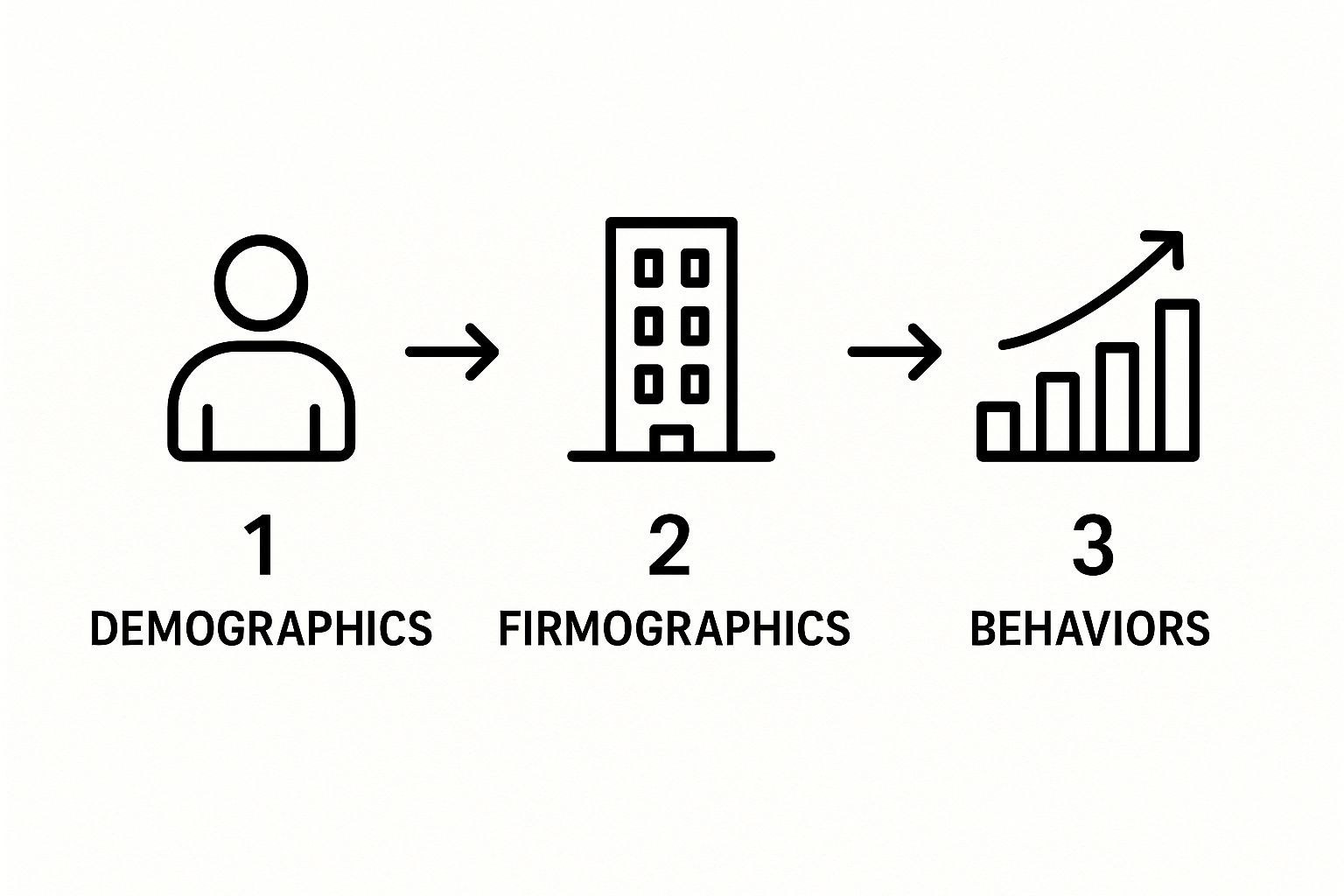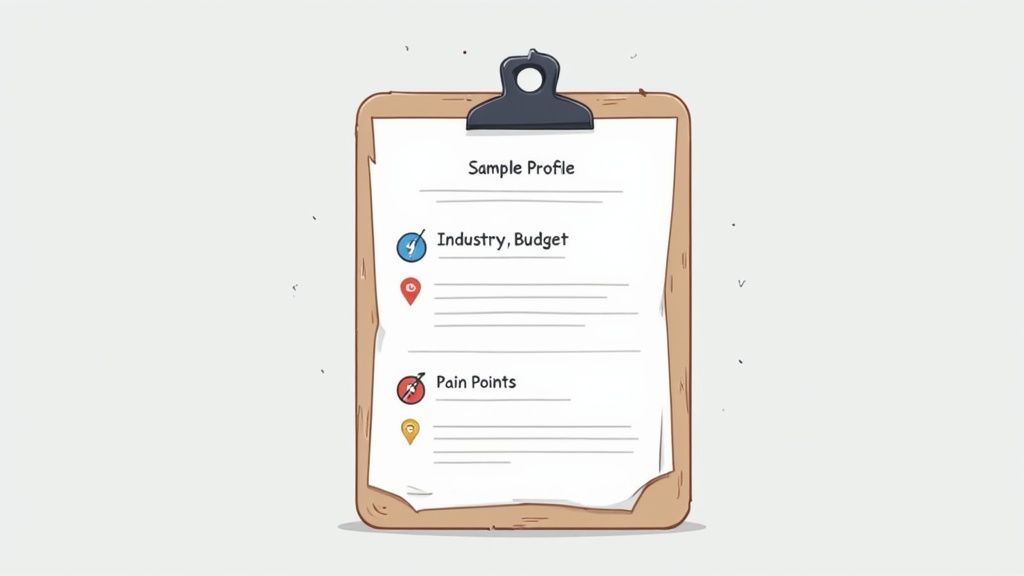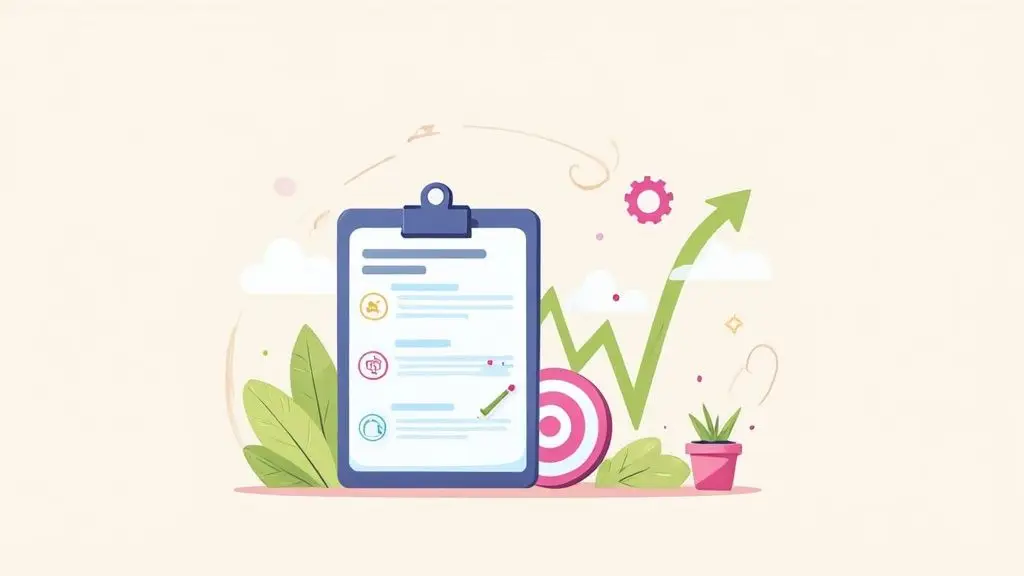Why Your Business Needs an Ideal Customer Profile Now

Do you ever feel like your marketing messages are disappearing into a vast digital echo chamber? Without a deep understanding of your target audience, it's easy for your efforts to lose their impact. This is precisely where the Ideal Customer Profile (ICP) steps in. More than just a simple buyer persona, your ICP is a comprehensive blueprint of your perfect customer. It’s the key to transforming scattered marketing efforts into focused growth. Want to delve deeper into understanding your audience? Explore this insightful article: How to master understanding your audience.
A well-defined ICP is essential for making the most of your marketing budget. It's about concentrating your valuable resources on those customers most likely to convert, become brand champions, and ultimately, boost your bottom line. A robust ICP template provides a unifying framework for your entire customer-facing team, ensuring consistent messaging and a coordinated approach. Resources like the guides from Haekka can offer valuable insights to further strengthen your understanding.
The Importance of ICP in B2B
In the B2B landscape, knowing your ideal customer takes on even greater significance. Sales cycles tend to be longer, with multiple stakeholders involved in the decision-making process. A well-crafted ICP helps streamline this complexity. By pinpointing key decision-makers, understanding their pain points, and tailoring your communication accordingly, you can shorten sales cycles, reduce acquisition costs, and see a significant boost in overall sales performance.
Creating a strong ICP has become a core focus for many businesses. Companies that adopt this customer-centric approach often experience notable improvements in sales conversion rates. An ICP template empowers businesses to align their marketing strategies with the specific characteristics of their highest-potential customers, unlocking opportunities for increased sales and revenue. This strategic emphasis on ICPs contributes to efficient resource allocation and a higher ROI on marketing investments. Want to learn more about the power of ICPs? Check out this resource: ideal customer profiles.
Beyond Basic Buyer Personas
While buyer personas often focus on individual demographics and characteristics, ICPs provide a wider lens. They delve into the firmographic details of the ideal company, including company size, industry, revenue, and organizational structure. This holistic perspective empowers B2B businesses to target entire organizations strategically, rather than solely focusing on individual buyers.
Practical Benefits of Using an ICP Template
A truly effective ICP template does more than just define your ideal customer—it transforms that knowledge into actionable strategies. It serves as a guiding star for everything from content creation and marketing campaigns to sales outreach and product development.
A structured ideal customer profile template takes the guesswork out of your targeting efforts. It provides a solid framework for collecting and analyzing customer data, uncovering key trends, and making informed, data-driven decisions. This structured approach ensures that your marketing and sales teams are working in perfect harmony towards shared goals.
The Anatomy of a High-Converting ICP Template
Creating an ideal customer profile (ICP) template is more than just filling in a spreadsheet. It's about transforming data into actionable insights that fuel business growth. This section explores the essential elements of a high-converting ICP template, highlighting how these components create a powerful tool for your teams.
Key Components of an Effective ICP Template
A truly effective ICP template delves deeper than basic demographics. It blends firmographic, technographic, behavioral, and pain point information to provide a comprehensive view of your perfect customer.
-
Firmographics: These details offer a snapshot of your target company's structure and market position. Important data points include:
- Company size (number of employees, annual revenue)
- Industry and niche area (e.g., SaaS, FinTech, Healthcare)
- Location (city, state, country)
- Funding stage (for startups and growing companies)
-
Technographics: Understanding your ideal customer's technology stack is essential, particularly in B2B. Include factors such as:
- Current software used (CRM, marketing automation platforms like Hubspot, etc.)
- Technology adoption stage (early adopter vs. late majority)
- Tech stack compatibility with your product
-
Behavioral Signals: These insights reveal how your ideal customer operates and makes purchasing decisions. Consider elements like:
- Buying habits (frequency, contract value)
- Decision-making process (key stakeholders, influencers)
- Content consumption preferences (preferred channels, topics)
-
Pain Points: Your ICP template must clearly define the challenges your solution solves. This includes:
- Specific business problems faced by the ideal customer
- The impact of these problems on their business (financial, operational)
- How your product offers unique value and addresses their needs
To illustrate these components further, let's examine the table below.
Introducing the table below outlining crucial ICP components, their significance, and how to collect relevant data.
| Component Category | Specific Data Points | Why It Matters | Data Collection Methods |
|---|---|---|---|
| Firmographics | Company size, industry, location, funding stage | Provides a basic understanding of the company's structure and market position | Publicly available databases (e.g., Crunchbase), company websites, LinkedIn |
| Technographics | Existing software used, technological maturity, tech stack compatibility | Reveals the customer's technology landscape and how your solution fits in | Website analysis tools (e.g., BuiltWith), case studies, surveys |
| Behavioral Signals | Purchasing patterns, decision-making process, content consumption habits | Uncovers how the customer operates and makes buying decisions | Customer relationship management (CRM) data, marketing analytics, customer interviews |
| Pain Points | Specific business problems, impact of problems, how your solution helps | Identifies the customer's challenges and how your product provides value | Customer surveys, feedback forms, sales team insights |
This table summarizes the key building blocks of a powerful ICP. By gathering and analyzing this data, you can paint a clear picture of your ideal customer.
From Template to Targeted Action
A strong ICP template empowers your teams to connect with the right customers, leading to shorter sales cycles, improved conversion rates, and ultimately, a healthier bottom line. Remember, your ICP template should be a dynamic resource. Regularly review and update it based on new information, market shifts, and feedback from your sales and marketing teams. Embrace a flexible approach and watch your ICP become an invaluable asset for driving sustainable business growth.
The 5-Step Process To Build Your Ideal Customer Profile

This infographic beautifully visualizes the three core components of an ideal customer profile: demographics, firmographics, and behaviors. These elements intertwine to paint a comprehensive picture of your perfect customer. By understanding these factors, you can create marketing strategies that truly resonate with your audience.
Building a solid Ideal Customer Profile (ICP) is a strategic process, not a guessing game. This 5-step approach, rooted in thorough research, helps you define ICPs that accurately reflect your business. It means delving deeper than basic demographics to understand the motivations behind customer decisions.
Step 1: Identify Your Super Users
Begin by exploring your current customer base. Pinpoint your super users: those who contribute the most revenue, demonstrate the highest lifetime value, and actively engage with your brand. They represent the heart of your ideal profile. For instance, if you're a SaaS company, identify customers consistently using key platform features and renewing subscriptions.
Step 2: Conduct Customer Interviews
Data analysis is essential, but direct conversations are invaluable. In-depth interviews with your super users offer rich qualitative insights. Ask open-ended questions about their challenges, motivations, and why they chose your product. This reveals the emotional drivers often missed by competitors. This can provide insights into what clients are looking for, which might interest you: How to Attract Clients.
Step 3: Analyze and Synthesize Data
Combine the quantitative data (demographics, purchase history) with qualitative interview findings. Look for recurring themes and shared traits. This synthesis provides a deep understanding of your ideal customer's needs, behaviors, and motivations. Now you can tailor your marketing messages to resonate with those most likely to become loyal customers. Creating an ideal customer profile involves identifying super users, conducting interviews, analyzing data, creating a template, and refining your findings. In B2B, focus on industries aligning with your product. For example, a tech company might target other tech companies with specific funding and growth potential. This detailed profile guides your marketing strategies, ensuring you reach the right audience. Learn more about creating an ideal customer profile.
Step 4: Create Your ICP Template
Formalize your research into a structured ideal customer profile template. This document becomes a central resource for your team. Include key firmographic data (company size, industry), technographic information (software used), behavioral insights (purchasing habits), and the specific pain points your product solves.
To further illustrate the process, let's consider an example timeline:
ICP Development Timeline
This table provides an estimated timeline for each step of the ICP development process, along with key activities and expected outcomes.
| Step | Estimated Time | Key Activities | Expected Outcomes |
|---|---|---|---|
| Identify Super Users | 1-2 weeks | Analyze customer data, identify top-performing customers | List of super users |
| Conduct Customer Interviews | 2-3 weeks | Schedule and conduct interviews, transcribe and analyze responses | Qualitative insights into customer needs and motivations |
| Analyze and Synthesize Data | 1-2 weeks | Combine quantitative and qualitative data, identify patterns and trends | Comprehensive understanding of ideal customer profile |
| Create ICP Template | 1 week | Develop a structured template, document key characteristics | Centralized resource for team alignment |
| Continuously Refine ICP | Ongoing | Monitor market trends, gather customer feedback, update template | Maintaining a relevant and effective ICP |
This timeline provides a framework, and the actual duration of each step may vary depending on the specific circumstances. However, by following these steps, you can ensure a robust and effective ICP development process.
Step 5: Continuously Refine Your ICP
Your ICP is not static. Market dynamics shift, customer needs evolve, and your offerings expand. Regularly review and refine your ideal customer profile template based on new data and feedback. This ensures your ICP stays relevant and continues to drive growth. This dynamic approach leads to improved targeting, more efficient marketing, and increased customer acquisition.
Transforming Data Into Actionable ICP Insights
Data, without a clear purpose, can be overwhelming. To create a truly effective ideal customer profile (ICP) template, you need to transform raw customer data into powerful, actionable insights. This means understanding not just who your ideal customer is, but why they choose solutions like yours. It's about uncovering the motivations and needs driving their decisions.
Identifying Valuable Data Sources
Several key data sources can provide the information needed for your ICP template. Your CRM system (like Salesforce) is a treasure trove of customer information, offering insights into demographics, purchase history, and customer service interactions. Analyzing website behavior through tools like Google Analytics reveals how potential customers interact with your content and where they might be encountering friction. Social media engagement reveals what resonates with your audience and the platforms they prefer. Finally, purchase history offers a valuable window into customer buying cycles, budget, and preferences.
Quantitative vs. Qualitative Analysis
Transforming data involves both quantitative and qualitative analysis. Quantitative analysis focuses on the numbers, seeking statistical patterns and correlations that predict customer success. For instance, you might find that customers who engage with a specific piece of content are more likely to convert. Qualitative research, on the other hand, explores the “why” behind customer choices. This involves techniques like customer interviews and focus groups to delve into the emotional drivers and motivations behind their decisions.
Avoiding Data Overwhelm and Maintaining Ethical Practices
The sheer volume of data available can be daunting. Focus on the metrics most relevant to your business model. If you're a SaaS company, metrics like usage patterns and integration capabilities are key. For a product-based company, focus on supply chain requirements and production volumes. For specific business tailoring, resources like Henri Den’s Branding Development Strategies can offer valuable insights.
Equally important is maintaining ethical data collection practices. Be transparent with customers about how their data is collected and used. Provide opt-out options and ensure secure data storage. Building trust through ethical data practices is essential for long-term success.
By combining data from various sources and using both quantitative and qualitative analysis, you can create a powerful ICP template. This template becomes a roadmap, illuminating not just who your ideal customers are, but also why they choose your solutions. This understanding allows you to refine your messaging, target your marketing more effectively, and ultimately, drive meaningful revenue growth. Learn more about creating effective customer profile templates.
Customizing Your Ideal Customer Profile Template By Business Model

Creating an ideal customer profile (ICP) template isn't a one-size-fits-all process. It's about adapting your template to the specific needs of your business model and industry. This ensures it's relevant and effective for your unique audience.
SaaS Vs. Manufacturing: Two Different Approaches
Think about the difference between a SaaS company and a manufacturing business. For SaaS companies, usage patterns and integration capabilities are key. Their ICP template might ask: "What other software do they use?" and "How often do they log in?"
For manufacturing businesses, supply chain requirements and production volumes are critical. Their template might ask: "What are their raw material needs?" and "What is their average order size?"
Tailoring Your Template: Examples Across Industries
This idea of customization applies to all kinds of business models. B2B service providers, product-based companies, enterprise sales organizations, and SMB-focused businesses all need specific templates. For example, a B2B service provider might prioritize client industry and project scope, while a product-based company could focus on customer demographics and purchase frequency. For more insights, check out this article: How to master building a purpose-driven brand.
- B2B Services: Focus on industry expertise, project budgets, and client testimonials.
- Product-Based Companies: Emphasize customer demographics, purchase frequency, and product usage.
- Enterprise Sales: Prioritize key decision-makers, contract value, and building long-term partnerships.
- SMB-Focused: Highlight budget constraints, quick wins, and ease of implementation.
Company Stage: From Startup to Established Business
Even within the same industry, a company's stage of growth influences the ICP approach. Startups searching for product-market fit prioritize early adopters and feedback. Their template might ask: "What are their biggest pain points?" and "Are they willing to provide feedback?"
Mature enterprises expanding into new areas focus on market share and standing out from the competition. Their template might ask: "Who are their current vendors?" and "What needs aren't being met?"
Asking the Right Questions, Prioritizing the Right Data
For each business model, identify the most relevant questions and data points. For SaaS, consider technology adoption and integration needs. For manufacturing, prioritize production capacity and supply chain reliability. This focused approach makes your ICP template a powerful tool for growth, focusing your sales and marketing efforts. A dynamic, customized ICP template is essential for aligning your team and connecting with the right customers at the right time.
Activating Your ICP: From Template to Revenue-Driving Action
A well-defined Ideal Customer Profile (ICP) template is a powerful tool, but its true power comes alive in its implementation. Let's explore how to transform your ICP insights into tangible actions that drive revenue and boost efficiency across your organization.
Marketing: Targeted Campaigns and Content That Connects
Marketing teams can use the ICP to create laser-focused campaigns. By understanding your ideal customer's preferred channels, content formats, and pain points, you can craft messaging that deeply resonates. This targeted approach minimizes wasted ad spend and maximizes engagement. For example, if your ICP is a tech-savvy CEO, LinkedIn might be a more effective platform than Facebook.
Consider the power of storytelling. Compelling narratives can forge strong connections with your ICP. Want to hone your storytelling skills? Check out these helpful storytelling tips.
Furthermore, integrating a Chatbot aligned with your ICP can significantly enhance customer experience. Explore how building a strategic persona for your chatbot can create more meaningful interactions.
Sales: Qualifying Leads and Building Genuine Relationships
For sales teams, the ICP is an invaluable qualification tool. By focusing on leads that closely match your ICP, sales representatives can prioritize their efforts and avoid pursuing less promising prospects. This targeted approach leads to shorter sales cycles and higher conversion rates.
Beyond qualification, the ICP empowers personalized outreach. Tailoring communication to the specific needs and pain points identified in your ICP fosters stronger connections and builds trust, laying the foundation for long-term partnerships.
Product Development: Creating Products That Solve Real Problems
Product teams can use the ICP to shape their development roadmap. By deeply understanding your ideal customer's challenges and desired outcomes, product teams can prioritize features that deliver real value. This customer-centric approach ensures that product development aligns with market demand and maximizes product adoption, setting the stage for sustainable growth.
Customer Success: Nurturing Long-Term Partnerships
Customer success teams can leverage the ICP to create targeted retention strategies. By understanding the ICP's definition of success and potential roadblocks, customer success managers can proactively address challenges and nurture long-term relationships. This proactive approach reduces churn and cultivates customer loyalty, transforming customers into advocates.
Measuring the Impact: Data-Driven Refinement
Implementing your ICP is an ongoing journey. Regularly tracking key metrics is crucial to gauge its effectiveness. Monitor changes in customer acquisition cost (CAC), sales cycle length, and customer lifetime value (CLV) to assess the real-world impact of your ICP implementation. This data-driven approach allows for continuous refinement, ensuring your ICP remains a powerful asset for sustainable revenue growth.
Ready to transform your business with clarity and purpose? Visit Henri Den to learn more about building a personal brand that resonates with and attracts your ideal customers.





